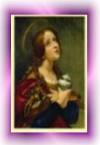Born in Ravenna in 1007, Peter Damian did not have an easy childhood. As he was the last of seven children, his mother thought she could not nurse him, and he almost died. Following his parents’ death, he was raised first by his sister, Roselinda, then by one of his brothers, who mistreated him, and then by his brother, Damian, who was the Archpriest of the Church of Ravenna. Peter added the name “Damian” to his own in honour of this brother. Thanks to his brother’s support, he was able to attend liberal arts courses and eventually became a teacher.
Peter entered the hermitage in Fonte Avellana, in the Marches region, in 1035, following in the footsteps of Saint Romuald, among the Camaldolese Benedictine monks, and became its spiritual guide. He was sought after by several monasteries because of his great wisdom and spirituality. When he returned to Fonte Avellana, he was elected prior. He revived the hermitage and wrote several works, including the Life of Romuald and a Rule for his monks.
Pope Stephen IX created Peter a Cardinal in 1057, and appointed him Bishop of Ostia, in order to keep him close by and rely on him for his reform. While he was in Rome, he also met the subdeacon, Hildebrand, who would later be elected Pope Gregory VII.
Peter served under six popes, who entrusted him with various missions, among them a journey to Milan alongside Fr. Anselmo da Baggio, to resolve a dispute involving the local clergy, who were married and dependent on the nobility, and the Patarini, who opposed Simoniacal and Nicolaitan priests.
In 1063, he defended Fr. Anselmo da Baggio, who had been elected Pope, choosing the name Alexander II, against the antipope Honorius II. However, because Peter continued to harbour the desire to withdraw into monastic life, in 1063, he asked the new Pontiff for permission to return to the hermitage in Fonte Avellana. He was granted his request, but his retreat to the hermitage was not absolute, as he was entrusted with ecclesiastical missions: in 1063, he travelled to Cluny to defend the privileges of the Benedictine Congregation of Cluny; in 1069, he travelled to Frankfurt to persuade Emperor Henry IV not to divorce; in 1071, he travelled to Montecassino for the consecration of the new abbey desired by Abbot Desiderius. It was not until 1066 that his resignation from the episcopal see of Ostia was finally accepted.
Peter travelled to Ravenna in 1072 to reconcile the city with the Pope, as Archbishop Henry had supported antipope Honorius II, which had resulted in an interdict on the city.
He died in the Benedictine monastery of Santa Maria Foris Portam in Faenza, on his return journey from his mission in Ravenna, and was buried in the Cathedral. He is mentioned in Dante’s “Paradise” and in the writings of Boccaccio and Petrarch. The faithful acclaimed him as a saint at his funeral. Pope Leo XII proclaimed him a Doctor of the Church in 1828.

